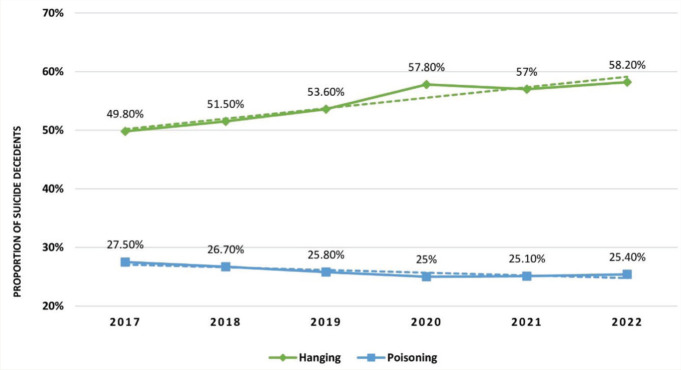Dear Editor,
Suicide is a significant public health concern. In India, the National Crime Records Bureau (NCRB) statistics showed a consistent, concerning rise in suicide rates from 9.9 per lakh population in 2017 to 12.4 per lakh population in 2022.1,2 The incidence rates of suicide displayed significant variability nationwide across states, ranging from 0.6 per 100,000 population in Bihar to 43.1 per 100,000 population in Sikkim. The southern cities of Vijayawada (42.6 per 100,000 population) and Kollam (42.5 per 100,000 population) reported the highest suicide rates in 2022. 2
There are a few noteworthy time trends here. First, suicides attributed to alcohol and substance use increased from 5.2% in 2017 to 6.8% in 2022.1,2 Further, this increase was most pronounced in the age group of 30–45 years. These trends highlight the need to focus on reducing substance use and reinforcing adaptive behavior patterns in suicide prevention programs. Screening, brief intervention, and referral services must be considered for at-risk individuals.
Another area of concern is the persistently elevated rate of suicide among students over the years 2017–2022, with numbers remaining consistently high (7.6% in 2017, 8.2% in 2020, 8% in 2021, and 7.6% in 2022).1,2 Failure in examination was the reported reason for suicide in 1.2% of students. Pertinently, suicide clusters have been reported in Kota, Thrissur, and Chennai; all these cities are famous for their coaching institutes targeting competitive professional examinations. 3 Promoting resilience to failure and frustration is crucial for preventing suicide among students, as is addressing issues such as peer pressure, family expectations, and poor coping skills. Media plays a vital role in suicide prevention, and responsible media suicide reporting is necessary to avoid the Werther effect. 4
Finally, the preferred means of suicide in India are changing. The proportion of suicides by hanging increased from 49.8% to 58.2%; in contrast, suicides by chemical poisoning declined from 27.5% to 25.4% from 2017 to 2022 (Figure 1).1,2 Limiting access to lethal means is an evidence-based suicide prevention strategy. 5 While means restriction is relatively more challenging to apply for hanging, specific steps such as removing or minimizing ligature points and the use of suicide-proof architecture in controlled environments such as schools, hospitals, and prisons may be considered.
Figure 1. Time Trends in the Major Means of Suicide in India (2017–2022).
An important aspect is the maintenance of continuity of care for patients with recent suicide attempts after discharge or crisis management. Establishing close follow-ups and the involvement of significant others in the management plan have been beneficial. 6 In this regard, the recently launched Tele Mental Health Assistance and Networking Across States (TeleMANAS) services can be leveraged. Apart from delivering prompt mental health support to individuals experiencing acute suicidal ideations, it facilitates a smooth care transition through referrals to specialized mental health services. 7
Given the continued rise in suicide rates within the country, the launch of the National Suicide Prevention Strategy (NSPS) in 2022 is an important and welcome step. 8 The goal of NSPS is to systematically address complex factors contributing to suicide and achieve a 10% reduction in national suicide rates by 2030. Key focus areas involve limiting access to suicide methods, enhancing healthcare systems for prevention, media sensitization, and reinforcing suicide surveillance. The NSPS urges the government to discontinue hazardous pesticides, expand post-graduate mental health seats, and provide short-term mental health training to non-specialist professionals. This comprehensive approach aims to promote mental health, prevent suicides, and intervene effectively across all levels, ultimately contributing to the reduction of suicide rates.
To sum up, suicide rates in India have shown a consistent rise in the six years, from 2017 to 2022, in contrast to global trends. Three notable trends in NCRB suicide data over the years are the increase in suicides attributed to substance use, the persistently high rate of student suicides, and the change in suicide methods. These trends are significant because they inform suicide prevention efforts and policy action aimed at reducing national suicide rates and enable staying on track to achieve the United Nations Sustainable Development Goals for 2030. 9
Footnotes
The authors declared no potential conflicts of interest with respect to the research, authorship, and/or publication of this article.
Declaration Regarding the Use of Generative AI: None used.
Funding: The authors received no financial support for this research, authorship, and/or publication of this article.
References
- 1.National Crime Records Bureau. Accidental deaths & suicides in India—2017; 2017. https://ncrb.gov.in/uploads/2022/July/11/custom/adsi/chapter-2-suicides-2017.pdf (accessed 30 December 2023. ).
- 2.National Crime Records Bureau. Accidental deaths & suicides in India—2022; 2022. https://ncrb.gov.in/uploads/nationalcrimerecordsbureau/custom/adsiyearwise2022/170161093707Chapter-2Suicides.pdf (accessed 30 December 2023. ).
- 3.Kar SK, Rai S, Sharma N, et al. Student suicide linked to NEET examination in India: a media report analysis study. Indian J Psychol Med, 2021; 43: 183–185. [DOI] [PMC free article] [PubMed] [Google Scholar]
- 4.Menon V, Mani AM, Kurian N, et al. Newspaper reporting of suicide news in a high suicide burden state in India: is it compliant with international reporting guidelines?. Asian J Psychiatr, 2021; 60: 102647. [DOI] [PubMed] [Google Scholar]
- 5.Arya V. Suicide prevention in India. Ment Health Prev, 2024; 33: 200316. [Google Scholar]
- 6.Carrigan CG and Lynch DJ. Managing suicide attempts: guidelines for the primary care physician. Prim Care Companion J Clin Psychiatry, 2003; 5: 169–174. [DOI] [PMC free article] [PubMed] [Google Scholar]
- 7.Sagar R and Singh S.. National Tele-Mental Health Program in India: a step towards mental health care for all? Indian J Psychiatry, 2022; 64: 117–119. [DOI] [PMC free article] [PubMed] [Google Scholar]
- 8.Ransing R, Arafat SMY, Menon V, et al. National suicide prevention strategy of India: implementation challenges and the way forward. Lancet Psychiatry, 2023; 10(3): 163–165. [DOI] [PubMed] [Google Scholar]
- 9.United Nations. Sustainable Development Goals Target 3.4. Non-communicable diseases and mental health; 2023. https://www.who.int/data/gho/data/themes/topics/sdg-target-3_4-noncommunicable-diseases-and-mental-health (accessed 5 February 2024. ).



